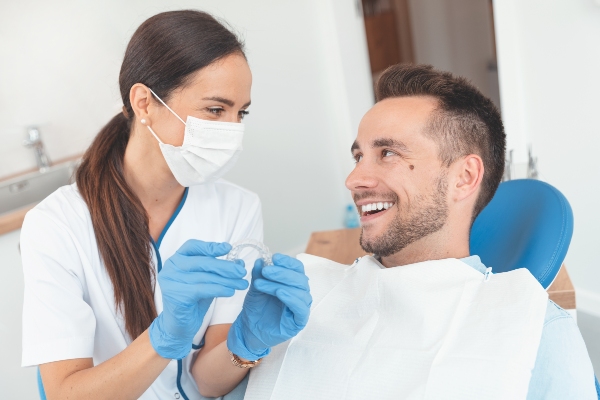A Comparison of Invisalign® and Traditional Braces for Straightening Teeth

Metal braces and Invisalign® aligners are two popular teeth-straightening solutions with proven outcomes among the many choices available. Straightening your teeth is a significant choice. Patients who have their teeth straightened benefit from better oral function, a lower risk of tooth decay and gum disease, and a general boost in self-esteem, thanks to their new smile.
Comparing Invisalign® and traditional braces
Invisalign and traditional metal braces both help to straighten misaligned teeth. Which method, though, is the most effective? Simply stated, one kind does not outperform the other; they merely operate in different ways. To understand the difference, it is important to evaluate how both of these options work.
An overview of traditional braces
Metal braces are made up of brackets and archwires that are attached to the teeth. They are the most common and extensively utilized kind of braces. The archwires provide constant, mild pressure to the brackets, causing the teeth to shift progressively over time. The wires are tightened and modified throughout the treatment duration to get the teeth to their ideal position.
Traditional metal braces are effective for all kinds of orthodontic issues, including overbite, underbite, and crossbite. Metal braces can effectively correct even the most complex orthodontic problems, which means they are an excellent treatment choice for individuals with severe malocclusions and crooked teeth. With metal braces, the typical treatment duration is around two years.
An overview of Invisalign
Invisalign is a system of custom-made, removable aligners that fit over the teeth like a mouthguard. The transparent plastic of the smooth aligners ensures that they are both comfortable and inconspicuous. As the patient's teeth progressively shift into their desired position throughout treatment, the aligners are changed every two weeks with a new set. The Invisalign aligners do not interfere with the wearer's lifestyle, considering the aligner trays can be taken out to eat, drink, brush, and floss normally.
Adults and teenagers may benefit from Invisalign if they have mild to moderate orthodontic issues, such as crowded or gapped teeth. However, Invisalign may not be the treatment of choice when complicated orthodontic problems are present. The average treatment period for Invisalign is six to 18 months.
Choosing between Invisalign and traditional braces
Most orthodontic problems may be effectively corrected with both conventional braces and Invisalign. The ideal option for the patient depends on the severity of the issues and the patient's preferences. Invisalign can address minor misalignments, but it may not work as fast as braces for back tooth problems, teeth requiring rotation or vertical movement, or existing bridgework. When it comes to complicated teeth problems, metal braces are often the best option.
Invisalign is difficult to beat in terms of convenience since users may take out the aligners to eat, drink, and clean their teeth normally. Of course, this technique requires self-discipline since aligners must be worn for a total of 22 hours each day to achieve the desired outcomes on time. For patients who may feel self-conscious about having braces, Invisalign aligners are the ideal option to consider.
Ready for a straighter smile?
Contact our dental office to book an appointment if you need teeth straightening treatment and want more information on Invisalign and traditional braces.
Request an appointment here: https://www.villadental.com or call Villa Dental at (301) 409-3583 for an appointment in our Bethesda office.
Check out what others are saying about our dental services on Yelp: Invisalign in Bethesda, MD.
Related Posts
An implant crown is the top part of a dental implant that connects to the abutment and titanium rod. It is also a type of dental restoration that can support, strengthen, and protect a tooth. On its own, a dental crown is a good dental helper. It is for people who want to regain the…
An emergency dentist can be a reassuring source of professional care in moments of sudden dental pain, injury, or complications. Addressing unexpected problems promptly helps prevent further damage and protect oral health. Having a clear plan and following expert recommendations will make managing stressful dental emergencies easier, maintain healthy teeth and gums, and reduce the…
Root canal treatment often appears as a reliable option for saving a severely damaged or infected tooth, while extraction removes the tooth entirely. Both options offer advantages and disadvantages, but a few factors help the dentist determine which procedure to perform. Understanding the benefits and considerations of each choice can help you become an active…
Dental crowns are an essential restorative treatment for patients who need to protect or strengthen a damaged tooth. However, like any dental restoration, crowns can encounter issues over time. Understanding these common issues and how to address them can help ensure a longer-lasting and more comfortable restoration.One of the most common problems with dental crowns…
